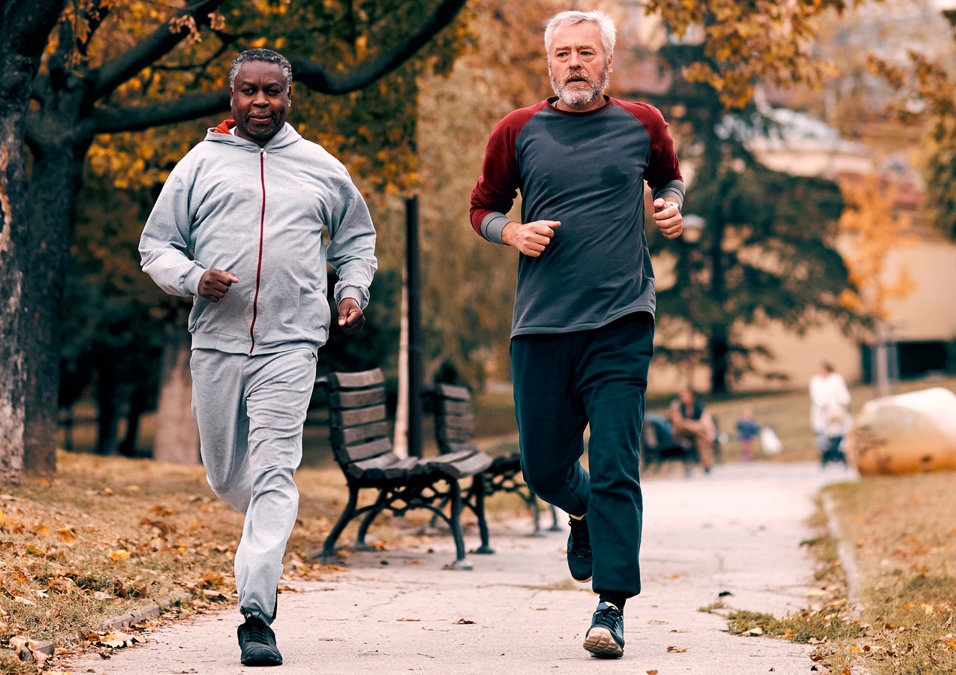Starting Fitness After 60: Expert Tips

SIGN UP FOR YOUR FREE DAY PASS TODAY!
Sir Jim Ratcliffe demonstrated that age doesn't have to hinder fitness with his remarkable performance at the London marathon yesterday. The 71-year-old completed the 26.2-mile run in just four hours, 32 minutes, and 52 seconds.
His impressive finishing time at the event marked a personal best for him over the distance.
Even after his run, he had enough energy to quickly make his way across London to watch his childhood club, Manchester United (in which he owns a 25 percent stake), play the second half of its FA Cup semi-final at Wembley.
Starting his run just after 10 am, Sir Jim is known for being an avid athlete who enjoys taking on challenges. However, staying in shape in your 60s doesn’t require being a fitness enthusiast; it’s about ensuring you’re following the best fitness advice for your age group.
While most people may not aim to match Sir Jim’s impressive performance, the NHS advises that older adults should engage in some type of physical activity every day.
According to the organization, physical activity can help improve your health and reduce the risk of heart disease and stroke. However, it warns that if you haven't exercised in a while, it's crucial to consult with a GP before starting any fitness routine.
This is especially important if you have medical conditions or concerns, as you'll need to ensure that your chosen activities and their intensity are appropriate for your fitness level.
Joanna Dase, from the international fitness franchise Curves, previously shared with FEMAIL that there are specific workouts and exercises suitable for each decade.
For those over 60, she recommended paying attention to balance and flexibility to remain safe and limber.
Joanna explained, "During your 60s, you can still do the same exercises you enjoyed before, but you might need to slightly modify the movements. For example, you can still do squats, but you may need to limit the range or the length of the hold."
She added, "As bone and muscle density decrease, it's essential to continue focusing on strength training while also maintaining balance and flexibility to stay safe and supple."
According to Joanna, there are several tips to keep in mind when starting a fitness routine in your 60s. She advised, "Keep it simple in your 60s.
Aim for a balanced, moderate daily routine doing activities you enjoy. With any exercise, your primary goals should be to prevent injury, increase mobility, and maintain quality of life through your movements."
The NHS suggests that those in their 60s should aim for some activity every day, even if it's just light. Light activities can include getting up to make a cup of tea, moving around your home, walking at a slow pace, cleaning and dusting, vacuuming, making the bed, and standing up.
For moderate activity, which is defined as leaving you able to talk but not sing, the NHS recommends aiming for 150 minutes weekly.
Exercise Guidance for Seniors 65+
Adults aged 65 and over should aim to incorporate physical activity into their daily routine, even if it’s just light exercise. They should focus on activities that enhance strength, balance, and flexibility at least two days a week.
Additionally, they should strive for at least 150 minutes of moderate-intensity exercise or 75 minutes of vigorous-intensity exercise per week, or a mix of both. Reducing the amount of time spent sitting or lying down and breaking up long periods of inactivity with some form of movement is also crucial.
If you have experienced a fall or are concerned about falling, exercises that improve strength, balance, and flexibility can help you become stronger and more confident on your feet. Activities such as walking for health, water aerobics, cycling, fitness dancing, doubles tennis, lawn mowing, and hiking are recommended.
Alternatively, aiming for 75 minutes of vigorous-intensity activity per week is another option.
According to the NHS, vigorous-intensity activity makes you breathe hard and fast, often limiting your ability to speak more than a few words without pausing for breath.
Generally, 75 minutes of vigorous activity can provide similar health benefits to 150 minutes of moderate-intensity activity. Most moderate-intensity activities can become vigorous if you increase your effort. Examples of such activities include running, aerobics, swimming, fast or hill cycling, singles tennis, football, uphill hiking, fitness dancing, and martial arts.
Exercising later in life offers benefits beyond physical fitness. A 2023 study discovered that exercising just once a month at any age could help prevent dementia in later years.
This was the first study to specifically examine the relationship between age, exercise, and brain health during retirement. Researchers from University College London aimed to determine whether the timing of an active lifestyle influenced brain health.
They found that staying active throughout adulthood is the most effective way to maintain good brain health in retirement. However, even starting to exercise in your 60s is beneficial.
The study revealed that individuals who consistently exercise as they age are more likely to have good brain health compared to those who exercise intermittently and then stop.
Any level of exercise—from brisk walking to gym workouts—enhanced participants' brain power compared to those who did not exercise at all.
Lead author Dr. Sarah-Naomi James stated, “Our study indicates that engaging in any leisure-time physical activity at any point in adult life positively affects cognition. This appears to be true even for light levels of activity, ranging from once to four times a month.
Moreover, individuals who have never been active but start exercising in their 60s also seem to have better cognitive function than those who were never active. The most significant cognitive benefits were observed in those who remained physically active throughout their life.
The effect is cumulative, so the longer an individual stays active, the more likely they are to maintain higher cognitive function later in life.”
Source: msn
The opinions shared in the GymNation blog articles are solely those of the respective authors and may not represent the perspectives of GymNation or any member of the GymNation team
GET YOUR FREE TRIAL TODAY














































































